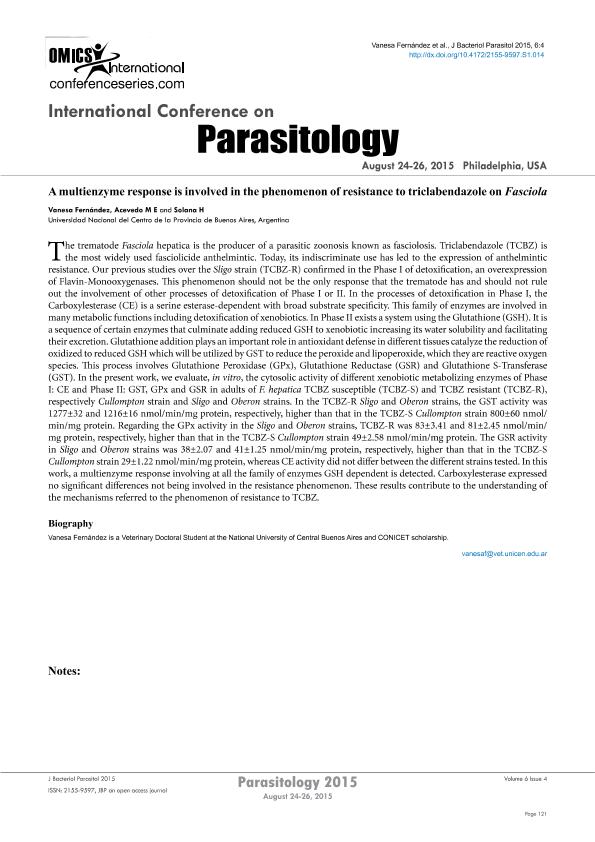Mostrar el registro sencillo del ítem
dc.contributor.author
Fernandez, Vanesa

dc.contributor.author
Acevedo, Maria E.
dc.contributor.author
Solana, Hugo Daniel

dc.date.available
2023-05-09T17:34:56Z
dc.date.issued
2015
dc.identifier.citation
A multienzyme response is involved in the phenomenon of resistance to triclabendazole on Fasciola; International Conference on Parasitology; Philadelphia; Estados Unidos; 2015; 121-121
dc.identifier.issn
2155-9597
dc.identifier.uri
http://hdl.handle.net/11336/196881
dc.description.abstract
The trematode Fasciola hepatica is the producer of a parasitic zoonosis known as fasciolosis. Triclabendazole (TCBZ) is the most widely used fasciolicide anthelmintic. Today, its indiscriminate use has led to the expression of anthelmintic resistance. Our previous studies over the Sligo strain (TCBZ-R) confirmed in the Phase I of detoxification, an overexpression of Flavin-Monooxygenases. This phenomenon should not be the only response that the trematode has and should not rule out the involvement of other processes of detoxification of Phase I or II. In the processes of detoxification in Phase I, the Carboxylesterase (CE) is a serine esterase-dependent with broad substrate specificity. This family of enzymes are involved in many metabolic functions including detoxification of xenobiotics. In Phase II exists a system using the Glutathione (GSH). It is a sequence of certain enzymes that culminate adding reduced GSH to xenobiotic increasing its water solubility and facilitatingtheir excretion. Glutathione addition plays an important role in antioxidant defense in different tissues catalyze the reduction of oxidized to reduced GSH which will be utilized by GST to reduce the peroxide and lipoperoxide, which they are reactive oxygen species. This process involves Glutathione Peroxidase (GPx), Glutathione Reductase (GSR) and Glutathione S-Transferase (GST). In the present work, we evaluate, in vitro, the cytosolic activity of different xenobiotic metabolizing enzymes of Phase I: CE and Phase II: GST, GPx and GSR in adults of F. hepatica TCBZ susceptible (TCBZ-S) and TCBZ resistant (TCBZ-R),respectively Cullompton strain and Sligo and Oberon strains. In the TCBZ-R Sligo and Oberon strains, the GST activity was 1277±32 and 1216±16 nmol/min/mg protein, respectively, higher than that in the TCBZ-S Cullompton strain 800±60 nmol/ min/mg protein. Regarding the GPx activity in the Sligo and Oberon strains, TCBZ-R was 83±3.41 and 81±2.45 nmol/min/ mg protein, respectively, higher than that in the TCBZ-S Cullompton strain 49±2.58 nmol/min/mg protein. The GSR activity in Sligo and Oberon strains was 38±2.07 and 41±1.25 nmol/min/mg protein, respectively, higher than that in the TCBZ-S Cullompton strain 29±1.22 nmol/min/mg protein, whereas CE activity did not differ between the different strains tested. In this work, a multienzyme response involving at all the family of enzymes GSH dependent is detected. Carboxylesterase expressed no significant differences not being involved in the resistance phenomenon. These results contribute to the understanding of the mechanisms referred to the phenomenon of resistance to TCBZ.
dc.format
application/pdf
dc.language.iso
eng
dc.publisher
Walsh Medical Media
dc.rights
info:eu-repo/semantics/openAccess
dc.rights.uri
https://creativecommons.org/licenses/by-nc-sa/2.5/ar/
dc.subject
MULTIENZYMATIC RESPONSE
dc.subject
FASCIOLA
dc.subject
TCBZ
dc.subject.classification
Ciencias Veterinarias

dc.subject.classification
Ciencias Veterinarias

dc.subject.classification
CIENCIAS AGRÍCOLAS

dc.title
A multienzyme response is involved in the phenomenon of resistance to triclabendazole on Fasciola
dc.type
info:eu-repo/semantics/publishedVersion
dc.type
info:eu-repo/semantics/conferenceObject
dc.type
info:ar-repo/semantics/documento de conferencia
dc.date.updated
2023-02-01T15:23:45Z
dc.journal.volume
6
dc.journal.number
4
dc.journal.pagination
121-121
dc.journal.pais
Reino Unido

dc.journal.ciudad
Londres
dc.description.fil
Fil: Fernandez, Vanesa. Consejo Nacional de Investigaciones Científicas y Técnicas. Centro Científico Tecnológico Conicet - Tandil. Centro de Investigación Veterinaria de Tandil. Universidad Nacional del Centro de la Provincia de Buenos Aires. Centro de Investigación Veterinaria de Tandil. Provincia de Buenos Aires. Gobernación. Comision de Investigaciones Científicas. Centro de Investigación Veterinaria de Tandil; Argentina
dc.description.fil
Fil: Acevedo, Maria E.. Universidad Nacional del Centro de la Provincia de Buenos Aires. Facultad de Ciencias Veterinarias. Laboratorio de Biología Celular y Molecular; Argentina
dc.description.fil
Fil: Solana, Hugo Daniel. Consejo Nacional de Investigaciones Científicas y Técnicas. Centro Científico Tecnológico Conicet - Tandil. Centro de Investigación Veterinaria de Tandil. Universidad Nacional del Centro de la Provincia de Buenos Aires. Centro de Investigación Veterinaria de Tandil. Provincia de Buenos Aires. Gobernación. Comision de Investigaciones Científicas. Centro de Investigación Veterinaria de Tandil; Argentina. Universidad Nacional del Centro de la Provincia de Buenos Aires. Facultad de Ciencias Veterinarias. Laboratorio de Biología Celular y Molecular; Argentina
dc.relation.alternativeid
info:eu-repo/semantics/altIdentifier/url/https://www.walshmedicalmedia.com/conference-abstracts/parasitology-2015-proceedings-60.html
dc.relation.alternativeid
info:eu-repo/semantics/altIdentifier/url/https://www.walshmedicalmedia.com/conference-abstracts-files/2155-9597.S1.014_021.pdf
dc.conicet.rol
Autor

dc.conicet.rol
Autor

dc.conicet.rol
Autor

dc.coverage
Internacional
dc.type.subtype
Conferencia
dc.description.nombreEvento
International Conference on Parasitology
dc.date.evento
2015-08-24
dc.description.ciudadEvento
Philadelphia
dc.description.paisEvento
Estados Unidos

dc.type.publicacion
Journal
dc.description.institucionOrganizadora
OMICS Publishing Group
dc.source.revista
Journal of Bacteriology & Parasitology
dc.date.eventoHasta
2015-08-26
dc.type
Conferencia
Archivos asociados
